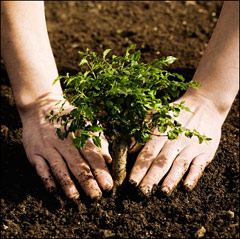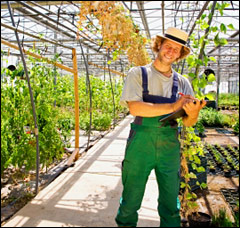Amid the din of the Pennsylvania primary and Earth Day, it seems a fitting time to talk about where the Democratic candidates stand when it comes to Mother Earth.

Have the leading Dems forgotten America’s greenest job?
Photo: Freaking News
Both candidates have called for ushering in a new green economy. Sen. Barack Obama has stressed that a green economy would not only save on energy costs but would help create jobs in manufacturing and in renewable energy infrastructure. And at a General Motors plant making parts for hybrids, Sen. Hillary Clinton declared that the factory “exemplifies” her notion of green-collar jobs.
Our nation could certainly use the “green-collar” jobs that the frontrunners have hailed as they wooed Rust Belt states like Ohio and Michigan and turned their attention to Pennsylvania. But unfortunately, they’ve missed one of the most hopeful green-collar jobs: farming.
This oversight is ever more lamentable because sustainable farming may actually hold one of our best hopes for addressing global warming, the biggest environmental crisis of all.
Though most of us don’t usually think about farming when we think about climate change, the world’s food system accounts for roughly one-third of human-caused greenhouse-gas emissions. Livestock production alone is responsible for nearly one-fifth of the world’s total emissions — that’s more than the globe’s total emissions from transportation.
The food system is particularly problematic because it is a major emitter of methane and nitrous oxide, which have (as many Grist readers probably know), respectively, 23 and 296 times the global warming effect of carbon dioxide. In the United States, widespread use of nitrogen fertilizer, much of which is wasted in leaching and runoff, accounts for three-quarters of the country’s nitrous oxide emissions. Globally, agriculture is responsible for nearly two-thirds of methane emissions.
The Democratic candidates are missing a huge opportunity to put food at the center of their green plans. For unlike many other strategies to address the climate crisis, we already know how to create a climate-friendly food system.

Get dirty to fight climate change.
We know, for instance, that organic farms decrease reliance on fossil fuels by working with nature to foster soil fertility, promote animal health, and handle pests and weeds. In fact, long-term studies from the Rodale Institute have found that organic farms use around one-third less fossil fuel energy than conventional systems for the same crops.
We also know that organic farming can play a critical role in mitigating climate change. By building healthy soil, organic farms create powerful carbon sinks, removing carbon dioxide from the atmosphere and fixing it in soil where it can remain as stable carbon compounds for thousands of years.
But we also know that to grow this sector we need to invest in the people who will get their hands in the dirt. And despite headlines about rising food prices and skyrocketing commodities, most American farmers are barely scraping by. With the average age of the American farmer creeping past 56, the need for beginning farmer initiatives has never been more paramount.
I managed to find, buried deep in their online rural policy platforms, that both Democratic candidates speak warmly about rural America — but neither seems to get the role of farming in a thriving rural (and green!) economy.
Nor has either candidate dared to address the role of the multibillion-dollar farm bill legislation that’s still being negotiated in Congress and how it could play a catalyzing role in fostering a truly green economy.
I asked the campaigns whether they include “farming/farmers” as part of their green-collar initiatives. The Clinton campaign didn’t respond. (I can’t say I’m surprised that Sen. Clinton hasn’t been raising this issue in her stump speeches: A little scratching would reveal her longstanding ties with Big Ag. Consider, for instance, that news blip back in October 2007, when ABC News found out that a “Rural Americans for Hillary” lunch was actually being held at the Washington, D.C., offices of a lobbying firm whose clients include companies like Monsanto.) The Obama campaign e-mailed back: “The Obama energy agenda will help rebuild rural communities across the country by investing in locally owned biofuel refineries, domestic carbon sequestration, and extending the federal Production Tax Credit,” a mechanism used by farmers across the country to install wind turbines and other renewable energy technologies on their lands.
Biofuel refineries? Call me quaint, but when I say “farming” and “farmers,” I mean the good old-fashioned kind: the kind that produce food for people to eat, not inputs for fuel for cars to consume. Besides, given the glut of ethanol on the market — and growing questions about what, if any, ecological value ethanol offers — funding yet more biofuel plants seems questionable.

Sustainable food is springing up in unexpected places.
Despite this lack of attention from the candidates and from the current administration, communities across the country have taken it upon themselves to foster a greener food system: farmers markets and edible gardens are popping up nationwide. Thousands of new farmers — women, young people, city folk, new immigrants — are taking the plunge into sustainable farming. Across the country, municipalities and states are introducing policies to support climate-friendly food, such as the historic bill passed in Washington state last month making it easier for food banks, schools, and low-income communities to access locally grown food. Here in New York State, the newly formed New York State Food Policy Council is getting serious about how to introduce such innovation on our side of the country.
These efforts show the potential to create the safe, affordable, abundant food system we all want and, at the same time, address the climate crisis.
As the Democratic candidates continue to battle it out post-Earth Day and post-Pennsylvania, I hope they realize the energy they could galvanize by putting green food initiatives at the heart of their rallying cry for a green economy.


